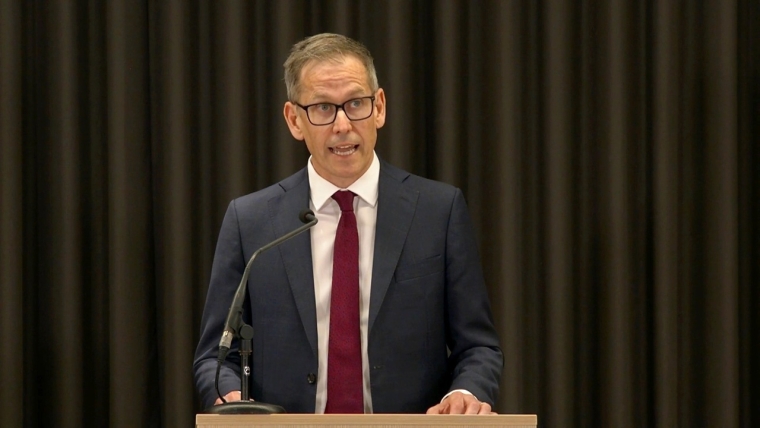
The Reserve Bank's departing temporary Governor wants to see the bank "off the front pages" next year.
Christian Hawkesby, in his final Official Cash Rate (OCR) media conference on Wednesday before handing over the reins to incoming Governor Anna Breman, spoke encouragingly of the prospects for next year.
The Reserve Bank (RBNZ) cut the OCR to 2.25% from 2.50% earlier on Wednesday, but gave clear indications that was likely the last cut unless something untoward happens. It was the last OCR review for the year, with the next one on February 18, which will be overseen by new Governor Breman.
Hawkesby said 2025 had been a challenging year, with the tariffs and general global uncertainty.
"We feel like we are coming out of the other end of that now. A lot of that is being resolved," he said.
He cited some of the action that the RBNZ had taken, including the 50 basis point cut in October, “which was designed to mitigate that risk of households and businesses being excessively cautious”.
"We are looking forward into next year and we want to be in a position where the Reserve Bank and monetary policy is off the front pages. Bring back boring. Let everything else drive the economy and we can sit in the back seat," Hawkesby said.
The set of forecasts in the new RBNZ Monetary Policy Statement (MPS) also released on Wednesday gave a low point for the OCR of 2.20% in June 2026.
Hawkesby said that new forecast track would be “consistent with the OCR being on hold throughout 2026”.
GDP figures for the June quarter released in September showed a sharp 0.9% drop.
But Hawkesby said there were "a lot of one off factors and statistical quirks" in the figures.
"It was not as weak as the headline number suggested - though it was on the weak side," he said.
“What we are seeing now is economic indicators picking up right through the course of high frequency indicators that we monitor.”
There were signs of both consumer spending and the labour market picking up, he said.
"There's] a whole host of small indicators that collectively give us confidence that we are not waiting for a recovery - it is happening right now through the third quarter and fourth quarter."
House prices expected to rise - but not by much
In its latest forecasts, the RBNZ is forecasting house prices will rise just 0.2% in 2025. That's actually a slight improvement on the last forecast in August, which was for a 0.3% fall in prices for this calendar year.
However, the forecast for next year has been trimmed very slightly, down from a 3.9% forecast for full year 2026 made in August to a new forecast of 3.8%.
Hawkesby said that it was expected house prices will grow roughly in line with income growth over the next few years "and that’s a good place to be in".
"It’s a world of a sustainable outlook where house prices are near sustainable and we are expecting them to continue on in that path."
RBNZ chief economist Paul Conway said while it was "too early" to call a structural change in the housing market, "there are some indications that might have happened".
Changes in zoning laws in Auckland over the years may mean housing supply, residential investment, is becoming more responsive to changing demand for houses "and if that is the case then we are less likely to see volatility in house prices and more likely to see changes in demand come through in terms of changes in residential investment".
What about fixed mortgage rates?
With the likelihood of the OCR now going on hold, there were questions asked by journalists around fixed mortgage rates and what would now happen to them.
Hawkesby said the RBNZ was "not going to direct the banks on where to set their rates".
Assistant Governor Karen Silk said banks are the ones that make the choice on this - not the RBNZ.
"They take a number of factors into account. They look at their own funding position and where that’s at.
"They’ve certainly got plenty of firepower there to be able to lend more, there’s no credit supply issue here in the New Zealand market. So, each bank’s funding position will be one of the determinants as to what they do with interest rates from here."
Silk went on to discuss bank margins.
"Where we see the, if you like, mark up on home loan rates today - it’s back to historic levels, the historic average levels that banks have had in that position. Now whether they can go further than that is ultimately their choice. That’s not something that we can direct. But competition in a low credit growth environment, I would be expecting that competition for those home loans as they roll over and go on to new rates, that competition will be healthy in this market. There’s certainly the capacity for it."
Silk said there had been periods where mortgage mark-ups "have been well above their historic averages".
"What we are saying is they are back to those levels now when you compare them relative to wholesale rates."
'Margins are healthy'
"I would suggest that the margins are healthy and there is room as I said, there is capacity for a competitive environment to bring them lower."
The RBNZ's figures on the average yields all banks have on their mortgage books show that this yield figure peaked at 6.39% in October 2024. This has now fallen to 5.4%. And the RBNZ says with close to 40% of fixed rate mortgages due to reprice over the December and March quarters, the average mortgage yield is expected to fall further to 4.7% by September 2026 based on current market pricing.
The RBNZ has previously commented on a slightly slower than expected pass-through of lower interest rates because many people have gone 'short' with their fixing in expectation of further rate cuts.
Silk expects that will change.
"If this plays out the way it is set out in our central projections and we see the OCR on hold effectively for that longer period, you will see more people start to move into that 18-month to two-year kind of bucket and that’s what will bring that average yield down."
Hawkesby gave upbeat final words.
“What does 2026 hold? It is going to be a period where inflation is falling towards our 2% target and one where the economic activity is recovering. That is a really good mix to have. That is a position that many central banks around the world would be very fond of sharing with us. So we are going into the year in a good position and we’ve got an OCR track which is going to give the Monetary Policy Committee a lot of optionality going into next year to continue that task of keeping laser focused on medium term inflation at the mid-point of the target."

We welcome your comments below. If you are not already registered, please register to comment.
Remember we welcome robust, respectful and insightful debate. We don't welcome abusive or defamatory comments and will de-register those repeatedly making such comments. Our current comment policy is here.